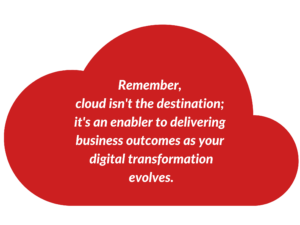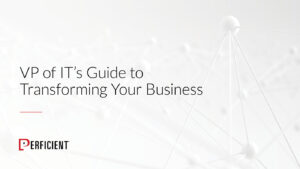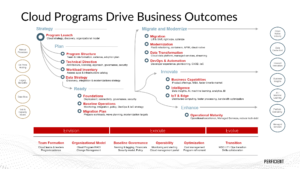In this blog series, we’re exploring the four pillars of a successful Cloud Transformation: Program Model, Cloud Foundations, Portfolio Transformation, and Enterprise App Migration. In our first blog, we discussed the importance of a Program Model and the key elements that should be considered for successful implementation. If you haven’t already, I highly encourage you to check it out. In this second segment, we’ll review the important “get right” technical elements of cloud adoption, which we refer to as “Cloud Foundations.”
Cloud Foundations focus on platform infrastructure, security, connectivity, and governance to ensure a secure and managed cloud environment is ready to support your migration and modernization goals to ultimately deliver impactful business outcomes and better serve your teams and end users.
The Elements of Cloud Foundations
This phase of your cloud adoption journey provides a trusted cloud baseline to inspire migration and innovation. It’s critical to get these areas right for security, manageability, performance and expansion – and to avoid costly rework down the road. Cloud Foundations should include these elements:

- Identity and Access Management: Integration with a centralized identity provider (Azure Active Directory, AWS IAM, Google Workspace, Okta, etc.), multi-factor authentication, single sign-on, security policies, user and device management.
- Infrastructure Security: Ensuring comprehensive platform security via firewalls, VPNs, traffic monitoring, data encryption, private endpoints, infrastructure as code best practices, governance policies.
- Networking Infrastructure: Designing your platform’s backbone networking model, core infrastructure shared services, domain controllers, DNS configuration, traffic routing optimization, and IP address management.
- Hybrid Connectivity: Connectivity across public clouds, private clouds, and on-premises networks for secure, effective, and reliable communication via VPN, private dedicated circuits, or SD-WAN.
- Cloud Governance: Effective governance policies and guardrails to ensure secure, compliant deployments across teams. This includes naming and tagging strategy, security policies, geographical restrictions, and regulatory guidelines.
- Comprehensive Monitoring: Resource observability across infrastructure and applications to comprehensively react to issues and proactively optimize performance via logging, cloud-native monitoring, third party tooling, and integration with existing ITSM, SIEM and other reporting systems.
- Infrastructure Automation: Ensure best practices, encourage efficiency with automation and avoid configuration and deployment issues with consistent infrastructure-as-code (IaC) tooling such as Terraform or Ansible.
- Backup & Disaster Recovery: Proactive strategies for backup and disaster recovery to minimize impact of potential outages, protect your data and restore your environments to maintain business continuity.
- Resiliency Design: Platform architecture design and best practices to ensure workloads successfully handle a reasonable level of service disruption or performance degradation by designing for multiple regions, availability zones, leveraging cloud-native redundancies or hybrid/multicloud architecture design.
- Cost Management / FinOps: Monitor and control cloud spend with effective tooling & monitoring strategies, budgets, alerts and operational reporting oversight to ensure cloud ROI meets expectations and encourages future investment.
How It All Comes Together
With a strong Cloud Program Model and an effective implementation of Cloud Foundations, you have set your organization on a path for digital transformation success. Ahead lies cloud migration, application modernization, data platform modernization and intelligent insights – all while maximizing investment, supporting sustainability, and providing organizational agility and resiliency.
Remember, cloud isn’t the destination; it’s an enabler to delivering business outcomes as your digital transformation evolves:
Next Steps
The next segment in our series will provide a clear direction for Portfolio Transformation – guiding your journey of app modernization with increasing velocity and long-term operational success.
In the meantime, we highly recommend checking out our free guide called the “VP of IT’s Guide to Transforming Your Business.” This guide provides further insights for VPs of IT and IT leaders on how to achieve success in cloud strategy, data, DevOps, and product development to set your organization up for continued growth and success.


